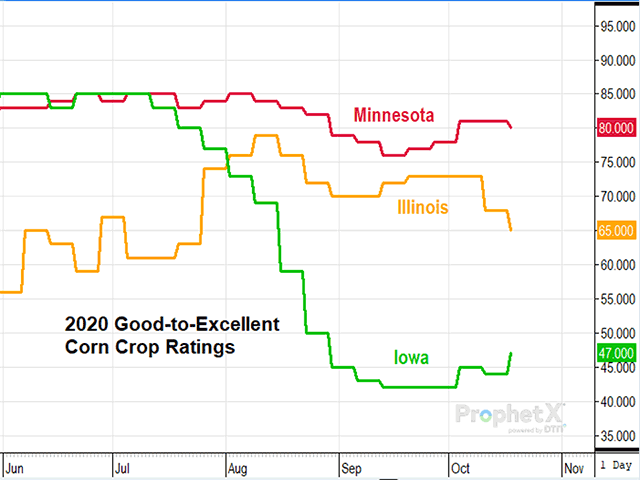Todd's Take
USDA Surprises Never Quit for Corn
In one sense, I shouldn't be writing another article on corn. DTN staff professionally reported the highlights of Tuesday's USDA reports and were followed by a fuller discussion of the numbers by DTN Senior Analyst Dana Mantini later that afternoon.
Read his recap here: https://www.dtnpf.com/….
DTN Contributing Analyst Alan Brugler dug even more into the details of USDA's corn numbers Wednesday, and as we have come to expect from Alan, no stone was left unturned.
Read that column here: https://www.dtnpf.com/….
So, what more could I possibly have to say about USDA's corn estimates, and, maybe more importantly, do Tuesday's reports deserve this much attention?
You'll have to be the judge, though I do think it's important to have at least one more conversation to have an appreciation for the uncertainties of corn's balance sheet moving forward.
Let me start by saying something so basic -- and I need to warn this is not meant to offend anyone -- but just because USDA estimates something, does not make it true.
P[L1] D[0x0] M[300x250] OOP[F] ADUNIT[] T[]
One year ago at this time, USDA estimated a 13.69 billion bushel (bb) corn crop, which drew boos from most farmers and this analyst as being too high. At farm meetings, it was easy to show cash prices were much stronger in relation to the futures market than usual. Subsequent grain stocks reports eventually showed that the corn wasn't there.
The January World Agricultural Supply and Demand Estimates (WASDE) report is often referred to as the final crop estimates for corn and soybeans, but it doesn't stop USDA from tweaking the numbers long after the January report. The 13.69 bb crop estimate of January 2019 was adjusted twice but is not much different today at 13.62 bb.
USDA's estimate of feed and residual demand in 2019-20, however, has been on quite the journey, going from 5.275 bb in the December 2019 WASDE report to 5.903 bb as of Tuesday. As an estimate of feed demand, it is not unusual to change through the year, but the residual part makes this account unique in that it often gets tasked for incorporating the findings of the quarterly grain stocks reports.
The good news is that the 628 million-bushel (mb) increase in feed and residual demand lowered corn's ending stocks estimate for 2019-20, just as if the same amount had been deducted from USDA's production estimate. The bad news is that the adjustments mess up any hope we have of understanding what are feed demand changes and what are inventory adjustments, related to overestimating production in the first place.
If we were trying to estimate feed demand, we would look at changes in beef, pork and poultry production, all of which showed small percentage gains in 2019-20 -- or we could use USDA's estimate of grain-consuming animal units, which showed a 2.1% increase for 2019-20.
But those basic feed demand factors would not explain the 8.7% jump in USDA's feed demand and residual estimate for 2019-20 to 5.903 bb in Tuesday's report. The bulk of that increase, I contend, came from overestimating corn production in 2019 and had little to do with feed demand.
Why did USDA make any adjustments at all? Because the quarterly grain stocks reports kept coming in less than expected and forced USDA to reflect the lower supplies somewhere in the balance sheet. Unfortunately, USDA's insistence on combining the residual with feed demand is unnecessarily confusing.
I know I'm not the first analyst to bring up these points, and I encourage others to keep putting slips in USDA's suggestion box. I congratulate Tom Vilsack, Seth Meyers and others in their new roles at USDA and say a prayer for all, as it is not easy to carry the weight of that responsibility.
From my little corner of the world, I want to help farmers understand markets so they can make good decisions about marketing their crops, and there are some areas USDA could help with. Separating out feed demand from the residual account is one of the easier fixes.
It's time for USDA to stop saying that China has 7.55 bb of ending corn stocks, and Russia's wheat ending stocks are probably overinflated as well. One of these days, the value of monthly grain stocks reports will be recognized and will take a lot of the guessing out of the market.
Until help arrives, we at DTN keep trying to explain which USDA estimates make sense and which ones we need to ignore. I don't know if USDA's lower-than-expected corn crop estimate of 14.182 bb is accurate or not ... the grain stocks reports will eventually decide.
Where will USDA's feed and residual demand land in 2020-21? I don't have a clue.
Todd Hultman can be reached at Todd.Hultman@dtn.com
Follow him on Twitter @ToddHultman1
(c) Copyright 2021 DTN, LLC. All rights reserved.




